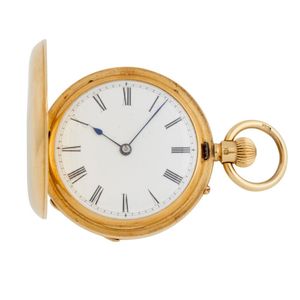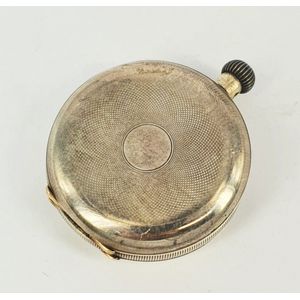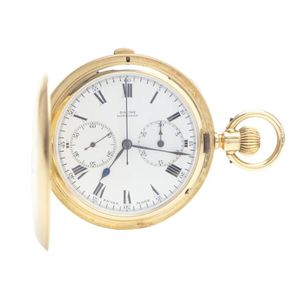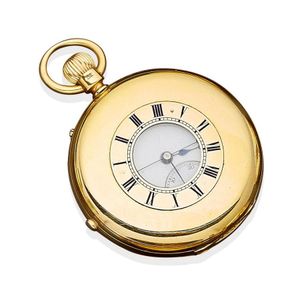
1890 18ct Gold Hunting Cased Pocket Watch with Heraldic Shield
18ct gold hunting cased pocket watch circa 1890, dial: white enamel Roman, spade hands, movement: English lever, crown wind, pin set. Case: polished hinged engraved with heraldic shield in Latin, the cuvette with presentation inscription, to Florence from…

18ct Gold Half Hunter Cased Pocket Watch by Hardy Brothers
An 18ct gold half hunter cased pocket watch retailed by Hardy Brothers Sydney & Brisbane circa 1900. Dial: white enamel Roman, subsidiary seconds. Movement: English lever, 15 jewels, no. 247697. Case: polished round, front cover with blue enamel Roman…

Antique Tavannes Gold Pocket Watch Set with Fob Chain
Tavannes 18ct yellow gold cased full hunter pocket watch, with antique 15ct gold fob chain (19 grams), and an antique fob seal, housed in a Hardy Brothers plush box.

Engraved Swiss Pocket Watch, Hardy Bros, Brisbane, 1897 Gift
A Swiss silver pocket watch, retail by Hardy Bros, Brisbane, hallmarked 0.935, not working; glass missing from face. Engraved back mechanism plate: 'Presented to Gerald H. Barlow. By some Toowoomba friends, January 1897'. Weight 119.3g.

Victorian Half-Hunter Watch by Hardy Bros, Sydney
A Victorian ladies 18ct gold case half-hunter watch, retailed by Hardy Bros, Sydney; 34 mm; front cover with circular enamel numeral dial (some wear: number 2-3 missing); all-over engraved foliate design. Internal back movement cover, very good condition;…

Antique Hardy Bros. Fusee Pocket Watch, London 1883
An antique hallmarked sterling silver full hunter fusee pocket watch, white enamel dial, Roman numerals, subsidiry seconds, case and swing out gilt movement signed Hardy Bros. Sydney no.15155 with engraved balance cock, compensation balance, guilloche…

Hardy Brothers 18ct Yellow Gold Chronograph Pocket Watch
A Hardy Brothers 18ct yellow gold split second chronograph full hunter pocket watch, the movement signed Hardy Brothers, London & Sydney, numbered 11179. The 18ct case hallmarked London 1869, maker's mark R. N. The white Roman numeral dial with two…

Longines Gold Chronograph Hunter Pocket Watch, 1920
A gold chronograph hunter pocket watch by Longines, crown wind and lever set, circular white enamel dial with black Roman numerals, subsidiary seconds at three and nine, signed case, dial and movement, 18ct gold monogrammed case, diameter 52 mm, retailed…

George V Silver Cased Giant Pocket Watch by Hardy Brothers
A George V silver cased giant pocket watch, the case with maker's mark of Syner and Beddoes, Birmingham 1916, retailed by Hardy Brothers, with engine engraved decoration, the Swiss watch with Arabic numerals, seconds dial and 8 day movement, retailed by…

Hardy Bros Sterling Silver Pocket Watch (Needs Servicing)
Large Hardy Bros open face pocket watch in sterling silver front travel case hallmarked Birmingham 1913 Hardy Brothers, 11.5 cm x 11 cm watch needs servicing

Hardy Bros 18ct Gold Carnelian Fob Watch (Missing Hands)
18ct gold and carved carnelian fob watch engraved Hardy Bros to interior plate. Hands missing.

George V Sterling Silver Travelling Clock
George V sterling silver cased travelling clock, Birmingham 1915, makers Hardy Brothers.;Monogrammed and engraved 1890-1915. Includes 8 days Swiss made watch clock, appears operational. in fitted leather case with sterling silver facing. Height 11 cm…

Hardy Bros 18ct Gold Hunter Pocket Watch
A lady's gold hunter pocket watch, 36 mm. Crown wind. Plain polished case. White dial with painted black Roman numerals. Dial and movement signed Hardy Bros. Movement number 259409. 18ct yellow gold. Total weight 49.46 grams. Boxed

1884 London Gold Chronograph Pocket Watch by Hardy Bros
A gentleman's gold half hunter chronograph pocket watch, London, circa 1884. Crown wind. 50 mm. Movement numbered 9654. Blue enamel chapter ring. White enamel dial and printed black Roman numerals, subsidiary seconds. Dial and movement signed Hardy Bros,…

1877 London Hallmarked Silver Full Hunter Pocket Watch with Key
Hardy Bros silver full hunter pocket watch, with key, Hallmarked London 1877

Sydney's Hardy Bros Enamel Half Hunter Pocket Watch
Sterling silver half hunter pocket watch, with blue enamel numerals. Retailed by Hardy Bros Sydney.

Gold Hardy Bros Chronograph Pocket Watch, 1884
Nicole Nielsen & Co., an 18ct gold half-hunter cased chronograph pocket watch mvt & case 9564 retailed by Hardy Brothers London circa 1884 English lever movement signed by retailer, white enamel dial, black Roman numerals and minute divisions, blued steel…

Hardy Brothers Enamel Dial Sterling Silver Fob Watch
Antique Hardy Brothers sterling silver fob watch with enamel Roman numeral dial front

18ct Gold Pocket Watch with Stag Engraving and Monogram
An 18ct gold open face pocket watch; white dial with black Roman numerals, subsidiary seconds, stem wind, push piece at 11 o'clock on a 15 jewel lever escapement, back cover engraved with a stag and Semper Vigilans (always watchful) within a ribbon,…

Antarctic Explorer's Gold Pocket Watch and Compass
A gold pocket watch from Antartic explorer Griffith Taylor. Explorer 1910-1913, presented as a 14ct yellow gold pocket watch, fob chain and compass having belonged to and inscribed to Antarctic Explorer Griffith Taylor, born, (1941 - (1880-1963), explorer…

Sterling silver pocket watch with travel case, 1915
J. H. Stewart half hunter pocket watch in an English hallmarked sterling silver travel case. Birmingham, 1915, maker Hardy Brothers

4 Vintage Watch Movements, Elgin and Hardy Bros
Four watch Movements; 2 Elgin, one by Hardy Bros, other unsigned, 41 - 40 mm.

Waltham Dress Watch with Gold-Filled Case and Arabic Dial
A Waltham dress watch with crown-wind lever movement; engined-turned gold-filled case, Arabic numeral dial and subsidiary seconds dial. (cased for Hardy Bros)

Rare 18ct Gold Split Second Pocket Watch with Chain
Hardy Brothers, London and Sydney, a very fine and rare 18 carat yellow gold keyless wind split second pocket watch no.11491. Case engraved with initials and crest of Walter Edward Mitchell, Towong Hill, Corryong, Victoria. 'Mieux Tard Que Jamais' (Better…

Hardy Bros 18ct Gold Pocket Watch with Enamel Dial
An 18ct gold half-hunting cased pocket watch, retailed by Hardy Brothers Ltd, circa 1890 English lever movement, engraved hinged cuvette with presentation inscription, white enamel dial, Roman numerals, subsidiary seconds dial, front cover with enamel…

18ct Gold Watch with Carnelian Seal & Seed Pearls
Hardy Bros 18ct gold watch with carnelian seal and seed pearls. Watch hands a/f

Hardy Bros London & Sydney 18ct Gold Fob Watch
18ct yellow gold fob watch (working), dial marked Hardy Bros London and Sydney

Swiss Goliath Pocket Watch by Hardy Brothers
A Swiss made goliath pocket watch, retailed by Hardy Brothers 6.5 cm diameter

Hardy Brothers' Sterling Silver Pocket Watch
Hardy Brothers, Birmingham, 1916 sterling silver cased large pocket watch eight day clock made in Switzerland and retailed by Hardy Brothers, Sydney and Brisbane

 Loading more...
Loading more...